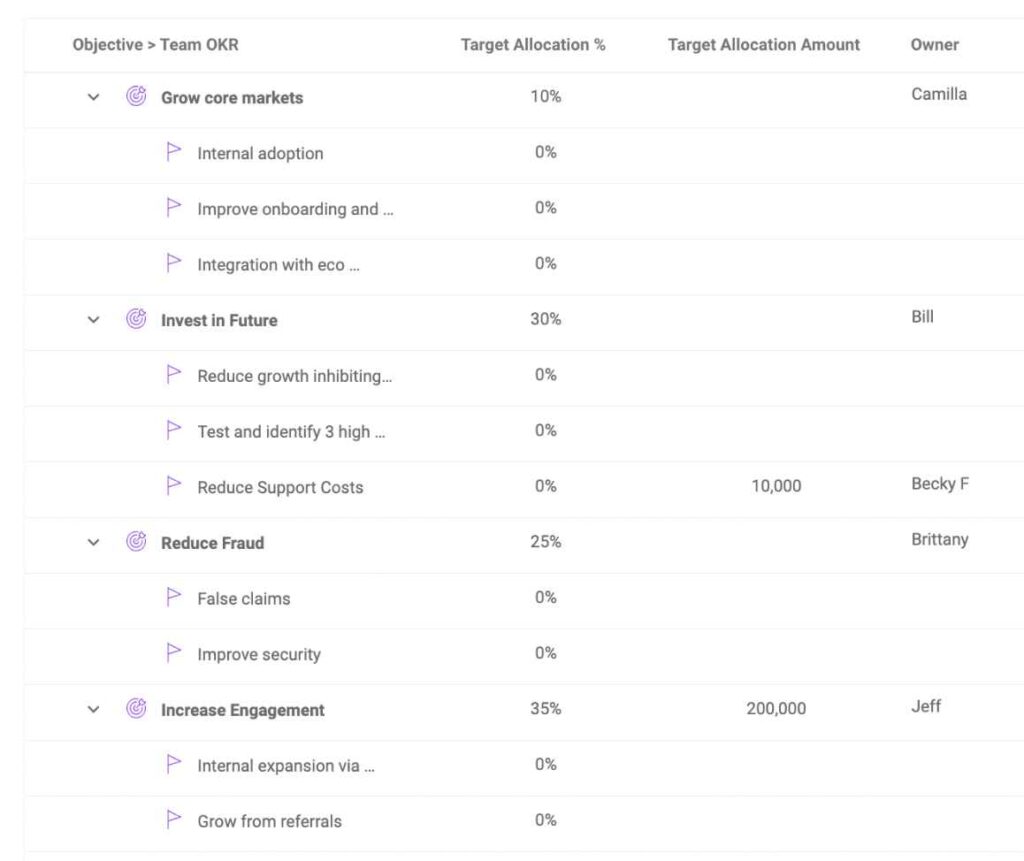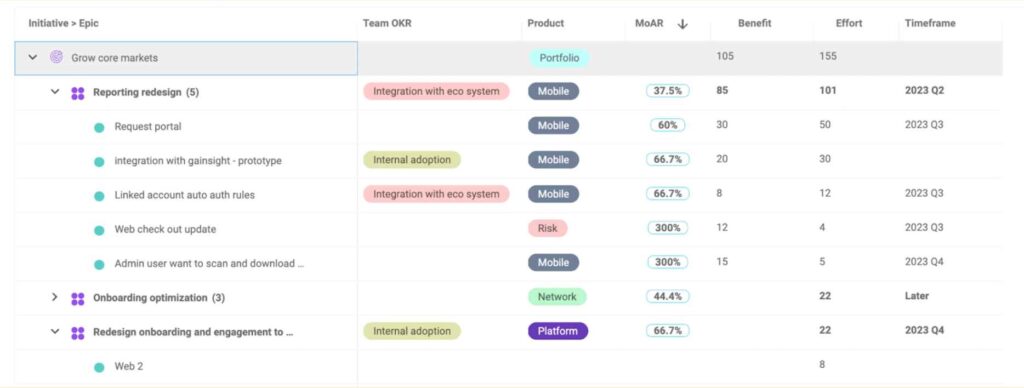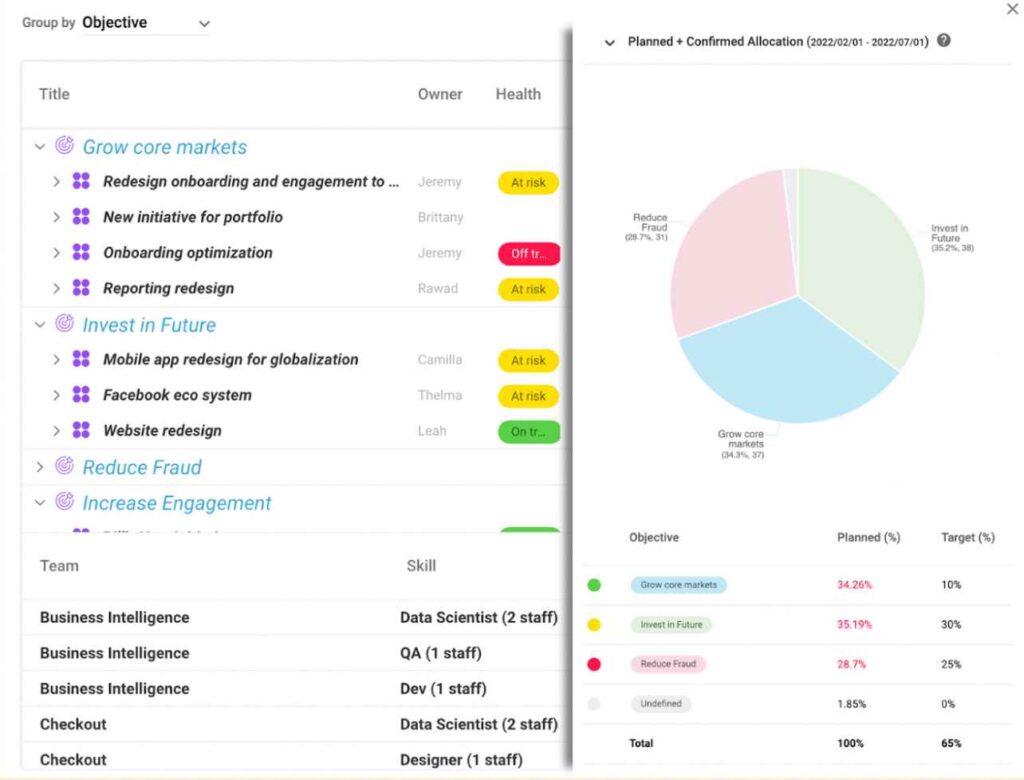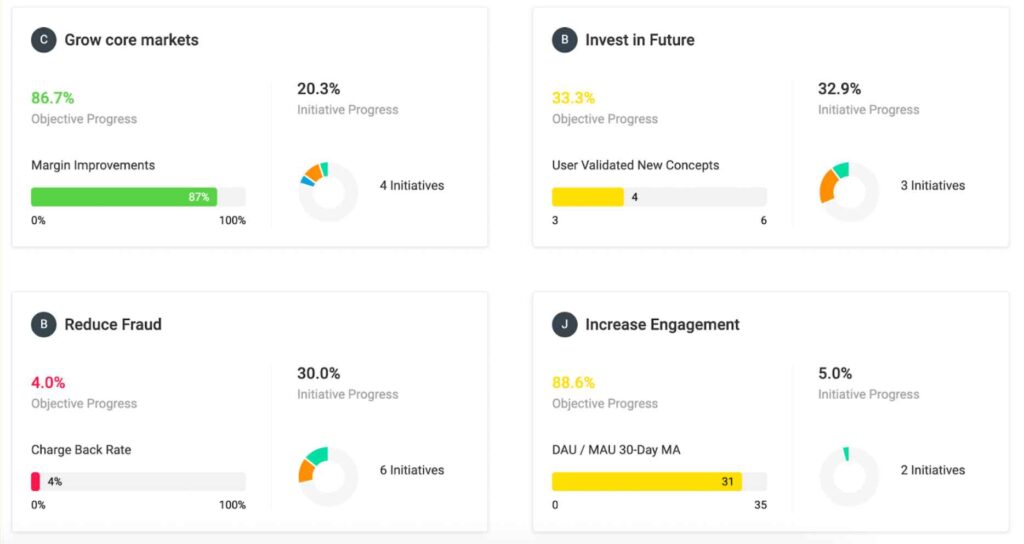Product management goes beyond addressing customer needs. It is about balancing customer requests, product initiatives, and your company’s strategic vision. If your organization uses OKRs as a goal-setting framework, aligning product OKRs and initiatives is key to determining which features to prioritize. In this blog, we will show you how to use product OKRs to create outcome-focused roadmaps and build customer-loved products that drive business success.
What is an OKR?
OKR stands for “Objectives and Key Results” – a framework for companies to set and track measurable goals. Objectives outline what you want to achieve, while Key Results help you measure progress.
Here are some key terms in the OKR product management framework:
- Goals: The high-level mission or vision of an organization.
- Example: Become the top digital banking service in the country.
- Objectives: Specific, measurable steps to achieve your goals.
- Example: Increase the number of users on our mobile banking app by 15% within the next year by adding new features and expanding marketing efforts.
- Initiatives: Specific projects that help you achieve your objectives.
- Example: Create and launch an in-app international money transfer feature.
- Key Results: Measurable outcomes showing progress towards objectives. These should be specific, quantifiable, and time-bound.
- Example: Reach a 15% increase in monthly active users of the app within six months of launching the new international transfer feature.
Companies use OKRs at the organizational, team, and individual levels. So, product OKRs are simply your product team’s OKRs (objectives and key results). Setting OKRs for product managers helps to align efforts toward achieving product-related objectives, such as increasing product adoption, that support the company’s strategic goals.
Product management OKRs are essential in driving product innovation and enabling data-driven prioritization decisions because they highlight the impact of each initiative on business outcomes. Then, once you establish product OKRs, you can maintain them throughout product roadmap planning, resource allocation, and progress tracking.
How Do Companies Use OKRs?
Companies apply OKRs to establish clear goals with measurable results and align teams around shared objectives. OKRs are used throughout an organization to promote transparency, accountability, and a focus on achieving impactful outcomes.
An Example of Multi-Level OKRs
To illustrate, let’s look at an example of how companies can use the OKR process to translate high-level business goals into specific team OKRs.
- Management Objective: Grow our business. Key Result: Increase annual revenue by 20%
- Marketing Objective: Optimize customer acquisition. Key Result: Reduce Customer Acquisition Costs (CAC) by 20% in Q3
This marketing OKR aims to optimize customer acquisition by reducing Customer Acquisition Costs. By lowering CAC, the marketing team can effectively acquire more customers with the same budget, ultimately contributing to the management OKR of growing the business. As a result, the company can allocate saved resources to other growth opportunities, further supporting the overall business expansion.
- Product Objective: Improve the quality of our products. Key Result: Resolve customer-reported bugs within two weeks
This product OKR example aims to increase product quality. By quickly addressing and fixing these issues, the company can enhance customer satisfaction and the user experience. As a result, this can lead to increased customer retention, positive word-of-mouth, and potential new customers, all of which contribute to the management OKR of growing the business.
- Customer Success Objective: Enhance enterprise customer satisfaction. Key Result: Increase satisfaction rate from 4.2 to 4.8
This customer success OKR aims to enhance enterprise customer satisfaction. By improving customer satisfaction, the company can foster stronger relationships with its enterprise clients, leading to increased loyalty, higher retention rates, and potential upselling opportunities. These factors directly contribute to the management OKR of growing the business.
Each team OKR is specific, measurable, and aligned with the overall strategic objective to increase annual revenue. So, the beauty of the OKR approach is that it allows you to measure progress at every level to ensure results.
How to Use Product OKRs in Your Outcome-Focused Roadmaps
- Define your product OKRs
- Prioritize product initiatives within OKRs
- Estimate the investment, then allocate resources
- Track progress in a product OKR dashboard
- Report results to stakeholders
So, let’s bring it back to product. An OKR Product Management approach improves outcomes by reducing the number of irrelevant roadmap features, streamlining release processes, and enabling better product-market fit.
Product teams use various tools for product management ranging from humble spreadsheets to complex software solutions. But when adopting an OKR product management approach, we recommend using a purpose-built tool like Dragonboat to connect product OKRs to outcome-focused product roadmaps seamlessly. Below we will show you how step-by-step:
1. Define Product OKRs
To create focus and alignment with your product OKRs, consider these three tips:
- Set quantifiable key results to measure progress while being mindful of prior OKRs for continuity.
- Confirm that your product OKRs align with strategic company goals
- Allocate appropriate resources to ensure achievable outcomes.
Using Dragonboat makes setting and managing objectives easy. You can add new OKRs, including product team OKRs, from any portfolio page and manage them from the goal-setting page or outcome module. The screenshot below shows you how this looks.
When defining OKRs, you can also allocate resources by percentage or absolute number, enabling you to track and monitor progress to keep teams and product roadmaps aligned. Once you define your product OKRs, they become the baseline for your entire product strategy.

When using a tool, you should be able to easily manage your objectives. In Dragonboat, you can Add, Edit, Merge, Archive, or Delete Objectives on the Feature Board page. From there, you can add subgoals to your OKRs to clearly map out your goal setting.
You can also add allocation, either by percentage or by an absolute number, for each OKR. So your target can later be matched with your plan to keep your teams and roadmap aligned.
You now have your OKRs clearly defined in your tool. Take your time with this step, as it will serve as the baseline for the rest of your product strategy.
2. Prioritize Product Initiatives Within OKRs
An outcome-driven organization prioritizes initiatives for the relevant OKRs based on how much they contribute to each objective vs. the effort required to deliver the benefit. The metric to measure this is called MoAR, or Metric Over Available Resources.
When using a product management tool such as Dragonboat, you can add features or initiatives and map them to OKRs, as shown below.

If you also use MoAR to evaluate and prioritize your features quantitatively, you can add your benefit score to the Feature List page, as illustrated.
3. Estimate the Investment, Then Allocate Resources
Although estimating the investment required to reach each objective and prioritizing initiatives is important, you must also allocate resources across all OKRs. So, Dragonboat provides a high-level view of resource needs and current allocations (shown below). Reviewing your allocations from this perspective allows you to re-balance to maximize the impact of your product efforts and achieve target outcomes.

4. Track Progress in a Product OKR Dashboard
To stay on track, monitoring the progress of your OKRs (outcomes) and product roadmaps (initiatives) is crucial. Dragonboat simplifies progress tracking by allowing you to easily view and update the status and health of your objectives and initiatives without any additional configurations.

The snapshot page above provides a convenient way for product teams and executives to view outcome and roadmap progress side-by-side, with all metrics displayed in a single pane.
For additional insight, integrations with tools like Jira, Github, or Asana provide real-time trend data, making progress tracking and roll-up reporting seamless.
5. Report Results to Stakeholders
You have spent a lot of time defining how your product OKRs can benefit your company, managing initiatives, and guiding your team’s work. Your progress is integral to your company’s success, important toward driving organizational alignment, and helps you focus on achieving outcomes rather than just delivering outputs.
A good tool will make sharing results with key stakeholders, executives, and team members easy. Below is a simple example of a report using Dragonboat.

Key Takeaways
Outcome-focused organizations often use the OKR framework to guide decisions and expect their product teams to do the same. When this is the case, aligning product OKRS to your product roadmaps can help you prioritize initiatives that will most impact business outcomes. That will enable you to make data-driven decisions and create transparency and accountability at all levels.
A purpose-built tool like Dragonboat can help you do this by guiding you through defining OKRs, prioritizing initiatives, allocating resources, and tracking and reporting results. Schedule a demo today to see it in action.
Categories
Product Leadership | Product Management | Product Operations | Quarterly Planning
Share on Social



